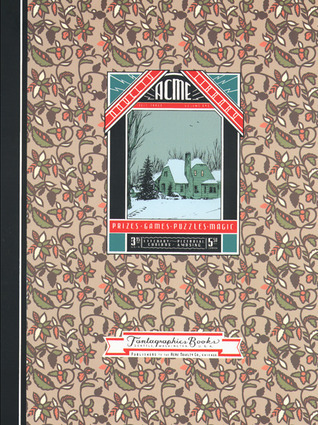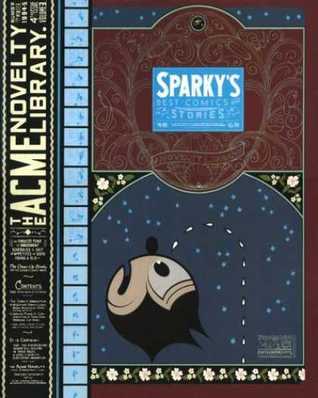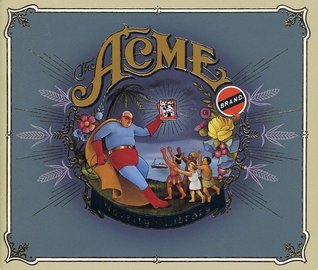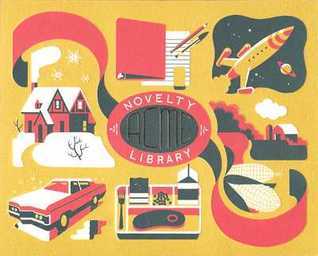


Books in series

#1
The Acme Novelty Library, Issue 1, Winter 1993–1994
Jimmy Corrigan
1993
The first issue of the Novelty Library focuses on Jimmy Corrigan, the Smartest Kid On Earth, though only two pages of this issue were later collected in the Jimmy Corrigan novel. In the main 24 page color story we see scenes from his life—as a young boy, as a young man, as middle-aged man, and as on old man. The time line skips back and forth, and it's left up to the reader to piece together a history from these glimpses into Jimmy's life.
An eight page inlay printed on news-print in black and white and a blue-grayish color has a six page nonsensical strip about Jimmy as a (for once) smart child. He builds rocket ships, shrinks himself, has an adventure and grows up. The ending of the strip is detailed on a full page of typeset text.
Also included is a one page Big Tex strip, a one page funny story about Jimmy fixing a new dad, one page of fake ads, and "A Splendid Toy Model" of Jimmy in his robot man persona on the back cover.

#2
The Acme Novelty Library, Issue 2, Summer 1994
Quimby the Mouse
1994
Acme Novelty Library #2. Featuring Quimby the Mouse. Originally published in 1994.

#3
The Acme Novelty Library, Issue 3, Fall 1994
Potato Guy
1994
Acme #3 presents one of Ware's earliest characters, the potato-shaped little fellow who starred in Ware's first RAW story. This issue reprints selected examples of Ware's college-era "daily" strips starring that character, as well as a longer story and other surprises, printed in an adorably tiny format. A great stand-alone issue to introduce new readers to the most critically acclaimed comic book series of the 1990s.

#4
The Acme Novelty Library, Issue 4, Winter 1994–1995
Sparky's Best Comics and Stories
1994
Acme Novelty Library #4. featuring Sparky's best comics and stories. Book is over sized.

#7
The Acme Novelty Library, Issue 7, Summer 1996
The Acme Novelty Book of Jokes
1996
Issue 7 of the Acme Novelty Library is tabloid sized and An untitled Big Tex story; Paw and Avery make a deal. A tour of the Acme company. Rocket Sam on the Mysterious Cave Planet Of Zanndor; Rocket Sam lands on a new planet. Text and illustration article redesigning the constellations. Untitled Big Tex story; Paw takes Tex shooting. Untitled Quimby The Mouse story; Quimby's night at home; presented as a cut out and construct miniature book. These Arms Were Made For Hugging; The Marooned Sam constructs a companion. Cut-out and construct miniature library. Scripts and art by Chris Ware.

#8
The Acme Novelty Library, Issue 8, Winter 1996–1997
Jimmy Corrigan, Part 3
1997
Comics for Adults Jimmy Corrigan continues!

#10
The Acme Novelty Library, Issue 10, Spring 1998
Mail Order Catalogue, Jimmy Corrigan
1998
The ACME Novelty Library #10 features an uncollected, sand-alone Jimmy Corrigan tale.

#13
The Acme Novelty Library, Issue 13, Autumn 1999
Jimmy Corrigan, Part 7
1999
Acme Novelty Library items by Chris Ware in the early 1990s.

#14
The Acme Novelty Library, Issue 14, Spring 2000
Jimmy Corrigan, Part 8
2000
This extra-length issue reveals the end of Jimmy Corrigan's quest, as he meets his half-sister—Ware's most sensitively delineated character yet—and a terrible tragedy tears apart his newly discovered family. A stunning climax to an amazing work.
2001 Eisner Award winner, Best Coloring
2001 Harvey Award Winner, Best Continuing Series

#15
The Acme Novelty Library 15
2001
"\[Chris\] Ware is the most versatile and innovative artist the medium has ever known," says Dave Eggers. We suspect that Ware won't be picking up cudgels to defend this title. For one thing, he's too busy creating brilliantly funny and insightfully quirky alternative comic books. In this 15th addition to his Acme Novelty Library, Ware flips out stories of favorites like "Jimmy Corrigan," "Rocket Sam," and, of course, "Quimby the Mouse." Well-twisted Ware fans will enjoy the pull-out bonuses, especially the cut-out three-dimensional motion picture viewer.

#16
The Acme Novelty Library 16
2005
The creator of Jimmy Corrigan begins a new story.
This newest edition of The ACME Novelty Library features the first serial installment of "Rusty Brown," Ware's first major lengthy "narrative indulgence" since his Jimmy Corrigan graphic novel. The ACME Novelty Library is Chris Ware's ongoing comic book/art object series, which he has been creating for Fantagraphics since 1993. It is also where Corrigan was serialized to great acclaim and success before going supernova when collected by Pantheon in 2000, selling over 70,000 copies in four hardcover printings.
"Rusty Brown" will be serialized in ACME over the course of several issues (and Pantheon will similarly collect the story in hardcover sometime upon completion, several years from now). The first installment begins with young Rusty, an outcast in his suburban Chicago elementary school, befriended solely by his Supergirl action figure until he meets new kid on the block and fellow comic nerd, Chalky White. Rusty's story is an uncomfortably vivid and uncompromising look into the life of a social outcast. Ultimately, Rusty Brown will run longer than Jimmy Corrigan, tracing Brown's life through adulthood, along with every excruciating moment of failure it brings.
The ACME Novelty Library series has been the most acclaimed comic book series of the last ten years, as well as one of the bestselling contemporary comics on the racks. This is only the second issue, however, that has been available to the general book trade, enabling booksellers to satisfy demand for Ware's work post-Jimmy Corrigan while Ware builds toward the next collection. The format also allows Ware to indulge us with many surprises as well, from Ware's faux-advertising sections and elaborate three-dimensional cut-out designs.
Author Biography: Chris Ware published his first comic strip in The Daily Texan, the student newspaper serving The University of Texas at Austin. He relocated to Chicago to attend the Art Institute in the late 1980s; he continues to reside there with his wife, Marnie. In his spare time, he creates The Ragtime Ephemeralist, a journal devoted to vintage ragtime music.

#17
The Acme Novelty Library 17
2006
Undaunted by lukewarm Internet and blogospheric opinion ("flat," "slow," and "always dreary") of his meretricious return last year to the tradition of the American comic book with the sixteenth issue of his ACME Novelty Library, cartoonist and professional sentimentalist Chris Ware returns with the seventeenth issue of this same title, and it is almost certain not to change general public opinion. Continuing with the second half of the introduction to his shamelessly meandering graphic novel Rusty Brown (which began last issue at a private school in the 1970s Midwest), the six-sided crystal suggested by the exegesis of the first installment is slowly turned and examined in midmorning winter sunlight sometime between the bell of first period and the conclusion of lunch for the first through the fourth grades. Also included are more thorough examinations of many of the main characters' cloudy motivations, personal habits, and favorite restaurants, to say nothing of the small dust mote around which they have coalesced and the complications in its life due to the acquisition of superpowers sometime the night before. Like the irritating distant family member you only have to see once a year, the ACME Novelty Library #17 will, as was its predecessor, be published by the author in a single, limited edition only, never to be reprinted until the entire library is collected as a single volume, though it may be promptly remaindered and/or discarded.

#18
The Acme Novelty Library, Issue 18, 2007
Building Stories, Part 2
2007
In keeping with his athletic goal of issuing a volume of his occasionally lauded ACME series once every new autumn, volume 18 finds cartoonist Chris Ware abandoning the engaging serialization of his "Rusty Brown" and instead focusing upon his ongoing and more experimentally grim narrative "Building Stories."
Collecting pages unseen except in obscure alternative weekly periodicals and sophisticated expensive coffee-table magazines, "ACME Novelty Library #18" reintroduces the characters that "New York Times" readers found "dry" and "deeply depressing" when one chapter of the work (not included here) was presented in its pages during 2005 and 2006. Set in a Chicago apartment building more or less in the year 2000, the stories move from the straightforward to the mnemonically complex, invading characters' memories and personal ambitions with a text point size likely unreadable to human beings over the age of forty-five. Reformatted to accommodate this different material, readers will be pleased by the volume's vertical shape and tasteful design, which, unlike Ware's earlier volumes, should discreetly blend into any stack or shelf of real books.

#19
The Acme Novelty Library, Issue 19, 2008
Rusty Brown, Part 3
2008
The penultimate teen issue of the ACME Novelty Library appears this autumn with a new chapter from the electrifying experimental narrative “Rusty Brown,” which examines the life, work, and teaching techniques of one of its central real-life protagonists, W. K. Brown. A previously marginal figure in the world of speculative fiction, Brown’s widely anthologized first story, “The Seeing Eye Dogs of Mars,” garnered him instant acclaim and the coveted White Dwarf Award for Best New Writer when it first appeared in the pages of Nebulous in the late 1950s, but his star was quickly eclipsed by the rise of such talents as Anton Jones, J. Sterling Imbroglio, and others of the so-called psychovisionary movement. (Modern scholarship concedes, however, that they now owe a not inconsequential aesthetic debt to Brown.) New surprises and discoveries concerning the now legendarily reclusive and increasingly influential writer mark this nineteenth number of the ACME Novelty Library, itself a regular award-winning periodical, lauded for its clear lettering and agreeable coloring, which, as any cultured reader knows, are cornerstones of any genuinely serious literary effort. Full color, seventy-eight pages, with hardbound covers, full indicia, and glue, the ACME Novelty Library offers its readers a satisfying, if not thrilling, rocket ride into the world of unkempt imagination and pulse-pounding excitement.

#20
The Acme Novelty Library, Issue 20, 2010
Lint
2010
Jordan Wellington Lint, fifty-one, is chief executive officer of Lint Financial Products, a company he began serving in 1985 as assistant and adviser before working his way up its corporate ladder to record-setting innovation in the fields of finance and high-yield investment. In his seven years as the head of Lint, Jordan has grown the company from a business lender and real estate speculator to a leading provider of network financial infrastructure services, all the while positioning Lint as a model of corporate integrity and high-yield, low-risk product. Lint’s vision has made him one of the most influential and widely sought-after leaders in the complex Omaha securities industry, and his fresh approach to an understanding of local problems, leadership, and determination have enabled Lint to outdistance and outpace its competitors.
Lint graduated from UNL in 1981 with a B.A. in business and briefly studied music and recording in Los Angeles before returning to his hometown of Omaha, Nebraska, where he has continued his life journey ever since. In his ongoing role as chief executive officer and his dual roles as public servant and father, Lint continues to put his creative leadership and vision to work in a variety of challenging settings. He is married and the father of two boys.
The ACME Novelty Library #20 comprises a contributing chapter to cartoonist ChrisWare’s gradual accretion of the ongoing graphic novel experiment "Rusty Brown".

#22
The Acme Novelty Library Final Report to Shareholders and Rainy Day Saturday Afternoon Fun Book
2005
Utterly eschewing the general bonhomie surrounding the newly-minted contemporary regard for the comic strip medium as a language of complicated personal expression and artistic sophistication, professional colorist and award-winning letterer F. C. Ware returns to the book trade with “The ACME Novelty Library,” a hardcover distillation of all his surviving one-page cartoon jokes with which he tuckpointed the holes of his regular comic book periodical over the past decade.
Sometimes claimed to be his “best work” by those who really don’t know any better, this definitive congestion of stories of the future, the old west, and even of modern life nonetheless tries to stay interesting by including a luminescent map of the heavens, a chart of the general structure of the universe, assorted cut-out activitites, and a complete history of The ACME Novelty Company itself, decorated by rare photographs, early business ventures, not to mention the smallest example of a Comic Strip ever before offered to the general public. All in all, it will likely prove a rather mild disappointment, but at least it catches the light in a nice way and may force a smile here and there before being shelved for the next generation’s ultimate disregard and/or disposal.

#23
The Acme Novelty Date-Book - Volume One
1986-1995
2003
Acclaimed cartoonist Chris Ware reveals the outtakes of his genius in these intimate, imaginative, and whimsical sketches collected from the years during which he completed his award-winning graphic novel Jimmy Corrigan: The Smartest Kid on Earth (Pantheon). His novel not only won the Manchester Guardian First Novel prize in 2001 but it has sold over 100,000 copies. This book is as much a companion volume to Jimmy Corrigan—one of the great crossover success stories—as a tremendous art collection from of one of America's most interesting and popular graphic artist.
Chris Ware has a passion for drawing that is surprisingly wide-ranging in style and subject. This book surprises the reader on every page with its sense of spontaneous vision. Architectural drawings from Chicago and interplanetary robot comics collide with cruelly doodled human figures and quietly troubling studies of the still life. A must for people with a passion for modern design and old-fashioned style.

#24
The Acme Novelty Date-book, Vol. 2
1995-2002
2007
Straggling behind the mild 2003 success of cartoonist Chris Ware's first facsimile collection of his miscellaneous sketches, notes, and adolescent fantasies arrives this second volume, updating weary readers with Ware's clichéd and outmoded insights from the late twentieth century.
Working directly in pen and ink, watercolor, and white-out whenever he makes a mistake, Ware has cannily edited out all legally sensitive and personally incriminating material from his private journals, carefully recomposing each page to simulate the appearance of an ordered mind and established aesthetic directive. All phone numbers, references to ex-girlfriends, "false starts," and embarrassing experiments with unfamiliar drawing media have been generously excised to present the reader with the most pleasant and colorful sketchbook reading experience available. Included are Ware's frustrated doodles for his book covers, angry personal assaults on friends, half-finished comic strips, and lengthy and tiresome fulminations of personal disappointments both social and sexual, as well as his now-beloved drawings of the generally miserable inhabitants of the city of Chicago. All in all, a necessary volume for fans of fine art, water-based media, and personal diatribe. This hardcover is attractively designed and easy to resell.

#26
Quimby the Mouse
1994
Cleverly appropriated old-fashioned animation imagery and advertising styles of the 1920s and 1930s are put to use in Quimby the Mouse at the service of modern vignettes of angst and existentialism. As this cartoon silhouette of a mouse ignominiously suffers at every turn, the spaces between the panels create despair and a Beckett-like rhythm of hope deceived and deferred (but never quite extinguished), buoying Quimby from page to page.
Like Ware's first book, Jimmy Corrigan, Quimby is saturated with Ware's genius, including consistently amazing graphics, insanely perfectionist production values, cut-out-and-assemble paper projects, and the formal complexity of his narratives that have earned him the reputation as one of the most prodigious artists of his generation.
This collection includes issues 2 and 4 of the comic book series with additional material.
Author

Chris Ware
Author · 28 books
CHRIS WARE is widely acknowledged as the most gifted and beloved cartoonist of his generation by both his mother and seven-year-old daughter. His Jimmy Corrigan: The Smartest Kid on Earth won the Guardian First Book Award and was listed as one of the 100 Best Books of the Decade by the London Times in 2009. An irregular contributor to This American Life and The New Yorker (where some of the pages of this book first appeared) his original drawings have been exhibited in the Whitney Biennial, the Museum of Contemporary Art in Chicago and in piles behind his work table in Oak Park, Illinois.